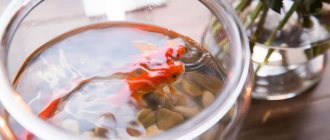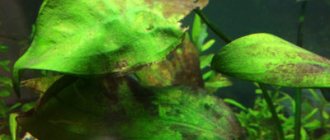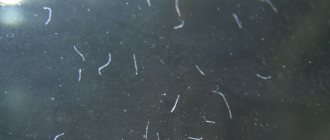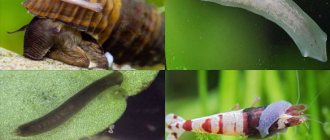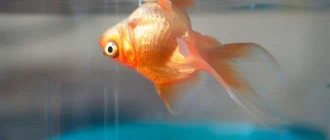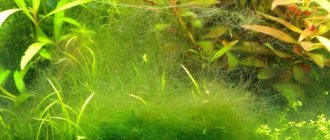White coating on the walls of the aquarium is a fairly common occurrence. As a rule, newbie aquarists encounter it. It occurs due to too high a content of organic substances in the water. A white coating usually develops on the walls in aquariums without living plants when the fish are over-fed or when using highly dusty food. The white coating consists of many small colonies of saprophytic bacteria that have found an abundant food resource for themselves. These colonies may look like shapeless lumps of whitish mucus or even look like thin, whitish, very small worms. However, under a magnifying glass one can see that these are just strands of bacterial mucus passively swaying in the current (if, of course, there is such a current in the aquarium). The white lumpy coating on the walls of the aquarium must be distinguished from the accumulation of hydras on the glass.
What is white plaque in the aquarium?
Whitish plaque is white lumps and individual hairs that look like worms from mucus, which appears due to the rapid growth of saprophyte bacteria. Their appearance is facilitated by the abundant food source that they acquired in the container.
Often, having noticed white mucus, inexperienced aquarium keepers begin to fight it using aquarium chemistry and not knowing that the sources of the problem are the mistakes of the aquarist, but not the mucus itself.
Do not confuse cloudy water with plaque, since cloudiness often occurs due to frequent changes of water, and plaque is due to bacterial damage.
White coating on fish, plants, driftwood, decorations, walls in the aquarium, how to treat it
To get rid of plaque, you need to tidy up the entire aquarium. To do this, you need to remove all rotten leaves and wash the filter from dirt. To avoid ammonia and nitrate buildup, it is important to replace 15-20% of the water.
It is very important to consider that the number of inhabitants of the tank should be proportional to its size. It may be necessary to change the food to a better quality one; overfeeding is also unacceptable.
If the aquarium has a sufficient volume, it is recommended to add “orderly fish”.
After the manipulations, you need to wait for the restoration of the aquarium microflora and the disappearance of white mucus from the walls of the aquarium, decor and plants.
Unfortunately, for aquarium fish, white coating can be a sign of illness. Only experienced aquarists distinguish cloudiness from a symptom of a disease. Among the diseases characterized by plaque, the following are common:
- alkalosis (alkaline disease);
- dermatomycosis (saprolegnia);
- gyrodactylosis;
- trichodinosis;
- Costiosis
Thus, it is important to monitor the health of aquarium inhabitants, and in cases of deviations from normal behavior and damage to the cover, begin urgent treatment.
Reasons for the appearance of white plaque in an aquarium
A common cause is overfeeding pets. Due to the large amount of food, aquarium fish do not have time to eat such an amount of food, which is why it remains on the bottom as an ideal environment for increasing the colony of bacteria.
Also, when the “dwelling of aquatic inhabitants” becomes polluted with dead leaves of vegetation, which gradually begin to rot, saprophytes multiply, for which excellent living conditions are provided.
Overpopulation of the aquarium, fish waste, and rare cleaning of the aquarium are also excellent conditions for the appearance of white mucus.
What could be the reason?
There may be several reasons why the water in an aquarium takes on a milky tint.
New Aquarium Syndrome
When you first start an aquarium, it takes time to establish balance in it. Beneficial bacteria, plants and other inhabitants have not yet become full participants in the nitrogen cycle.
It proceeds according to the following scheme:
- A high concentration of ammonia is created, which is produced by fish.
- The population of bacteria that process ammonia is increasing.
- Ammonia levels drop, but equally toxic nitrites appear in large quantities.
It is at these stages that the increased concentration of ammonia in the water, and then nitrites, causes the water to turn white.
The cycle ends with the birth of bacteria, which oxidize nitrites, releasing the final product - nitrates . These are no longer such “evil” bacteria, and their level is easily regulated by nature itself.
Bacteria begin to work as a biofilter, simultaneously reducing the whiteness of the aquatic world.
Another reason for whitish water is the use of poorly washed soil when starting the system. This usually appears soon after filling the aquarium.
Excessive water changes
Whiteness sometimes causes trouble not only in aquariums with fresh water, but also in well-established aquatic systems.
The reason for this is large volumes of replaced water, usually more than 30%. With this “refreshing” of the aquarium, beneficial bacteria are simply washed away.
As a result, the nitrogen cycle is disrupted, and whitish turbidity appears in the aquarium. One of the important rules of aquarium keeping is not to make a 100% water change unless necessary.
Bacterial outbreak
Another reason for a force majeure situation with the appearance of white turbidity in an established aquarium can be a bacterial outbreak. This is a massive proliferation of bacteria.
The main causes of bakflash:
- excessive portions of food that is not eaten by fish;
- excessive concentration of its inhabitants, inappropriate for the volume of the aquarium;
- overdose of fertilizers;
- absence or malfunction of filtration and oxygen enrichment systems;
- irregular cleaning of the aquarium;
- absence or insufficient soil layer.
The main process of biological purification occurs in the soil, and it is in it that colonies of beneficial bacteria settle.
Brown plaque in the aquarium: what to do and how to get rid of it
When a brown coating appears, it is worth thinking about the correct lighting of the aquarium and its cleanliness. With a lack or excess of light, there is an increased proliferation of single-celled microorganisms called diatoms. They are what cause this rusty, unattractive coating.
To make the lighting suitable, you should purchase special lamps designed for aquarium keeping.
Reasons for the appearance of brown plaque in an aquarium
Leftover food, various fertilizers, organic waste, the presence of iodine and table salt in the water contribute to the appearance of brown mucus, which can subsequently turn even blacker. If you do not clean the tank in time from the “favorite delicacies” of brown diatoms, the rusty deposits will only increase.
How to get rid of brown deposits in an aquarium
To remove brown plaque, algaecides and potassium fertilizers are used, which normalize the water balance. Shrimp, snails, ancistrus, otocinclus sponges feed on these colonial microorganisms, and therefore are excellent helpers in the fight against these “enemies.”
Also, to get rid of brown pests, a weak solution of potassium permanganate helps, and you need to replace infected plants with new ones, disinfect the soil and frequently change 1/3 of the water.
You can overcome brown plaque using Cidex.
What are the consequences for the fish?
The whitishness of water in an aquarium that does not go away for a long time not only makes its underwater world unsightly, but the reasons for this phenomenon cause significant harm to the fish.
Consequences that result from untimely removal of whiteness in water:
Colonies of bacteria absorb oxygen, and the fish begin to suffocate.- Metabolic products (life activities) of bacteria are poisonous to fish, and without human intervention they can die.
- Nitrites block the transport of oxygen in the circulatory system of fish, and increasing their content to 1.0 mg/l is already fatal for most fish.
- The ammonia that accompanies the phenomenon of whitish water causes burns in fish, especially their delicate gill filaments.
Protecting itself from the burn, the fish begins to secrete mucus. This secretion clogs the gills and prevents her from breathing normally.
Black plaque on rocks and plants in an aquarium - how to get rid of it
This plaque mainly appears on the plants and rocks of the aquarium. Common causes are rotting vegetation or dead fish, which should be addressed immediately.
Representatives of the genus Compsopogon can infect an aquarium and its contents. These representatives of Red algae are popularly called blackbeard. When plants are damaged, black beard penetrates the leaves, damaging the cells.
It is very difficult to get rid of this disease, but it is possible. To do this, it is recommended to keep Siamese algae eaters and red horned coils, for which compogon are food.
You can also use a chemical agent, for example, Sidex or hydrogen peroxide 80 ml per 100 liters of water. Before pouring peroxide, you need to take 1 liter of water into a separate container and dilute the peroxide there, then pour it into the aquarium.
You need to change the water by 30-40% after a week to pre-prepared settled water. The inhabitants of the aquarium (fish, shrimp, snails) do not need to be removed while pouring peroxide. Hydrogen peroxide - breaks down into oxygen and hydrogen, which has a negative effect on black beards.
Peroxide can be bad for aquarium plants!
How to treat trichodinosis
Trichodinosis in fish is caused by ciliates. Externally, the disease does not appear immediately. The fish may behave in the same way as during other infections: rubbing against stones, rising to the surface for air, or grabbing bubbles from the aerator. Over time, a white coating is observed on the scales, and mucus envelops the gills. The pet is indifferent to food and breathes frequently.
Infection is often brought into the aquarium with food (usually live), algae, or sand. It can be brought by affected individuals. Without the presence of fish, the container self-cleanses itself of parasites in a few days.
If the disease is not advanced, you can get rid of it using salt. The affected individual is placed in a quarantine container. Prepare a solution for disinfection: 10 liters of settled water will require 20 grams of ordinary salt. It is recommended to raise the temperature to the maximum (30 degrees) and start intensive aeration.
Prevention of plaque in the aquarium
Of course, in order to avoid various deposits in the aquarium, you should clean it in a timely manner and properly care for it.
As a preventive measure, you need to regularly, once a week, replace 30% of the water with clean, settled water. Clean the soil periodically with a siphon. Avoid overcrowding and overfeeding. It is important to give the fish high-quality food in small portions 1-2 times a day and provide the aquarium with a good filtration system.
Share with friends on social media. networks
10% DISCOUNT FOR BUYERS FROM REGIONS OF RUSSIA AND CIS COUNTRIES FOR AQUARIUMS, FISH, PLANTS, ETC.
What to do if the aquatic environment turns white?
Milky water syndrome can occur both in a new aquarium and in an already established aquatic environment. Despite the fact that the algorithms for combating this scourge are similar in both cases, there are a number of features.
In a new container
To eliminate white water in a starting aquarium, you must:
- Siphon the soil with a soil cleaner.
- Reduce the concentration of fish. Occupancy standards for different species are a separate topic, but they must be known and observed.
- Check the water volumes for compliance and, if necessary, increase the filter power.
If the problem persists, it is recommended to carry out partial water changes in small portions. After these procedures, you need to siphon the soil.
You should not clean the filter in a new aquarium - beneficial bacteria are still settling in there.
Turns white in the habitable
The main thing that needs to be done when whitish water appears in an inhabited aquarium is to carry out unscheduled cleaning according to the following algorithm:
Use a soil cleaner to collect all remaining food from the bottom;- wash the filters;
- significantly reduce the diet of the inhabitants of the aquarium; you can completely stop feeding for several days;
- after the water becomes clear, begin to gradually replace it - at first - no more than 20%, with further, over the course of several days, replacements of 10-15%;
- once again siphon the soil from dead microorganisms.
Additionally, to combat whitish water in an old aquarium, you can:
- Cover the bottom with a layer of well-washed coarse quartz sand if fish raise turbidity in search of food.
- Use synthetic padding wool in the internal filter, replacing it daily until the “milk” disappears;
- Launch a large number of snails - ordinary coils. Mobile slipper ciliates that actively live in their mantle are predators in the microcosm. They eat other bacteria and the whiteness will gradually disappear.
- Use a pump filter with a cartridge, popularly known as a “lifesaver for blondes.”
- Apply an aquarium coagulant. It neutralizes organic matter and inorganic impurities dissolved in water.
- Install a UV sterilizer.
Water sterilization should be approached with a very careful dosage so as not to destroy beneficial bacteria that process ammonia, despite the fact that most of them live in the soil.
The negative impact of cloudy water on the aquarium ecosystem
Most bacteria in an aquarium are aerobes because the environment is predominantly oxygen. When heterotrophs are abundant, they waste oxygen. A depleted oxygen environment poses a risk to fish health.
Overfeeding of fish, accumulation of dead fish carcasses or dead plant matter leads to an increase in the population of heterotrophs. With the beginning of mineralization of organic matter, more ammonium is gradually formed, followed by the development of nitrifying autotrophs. The ammonium concentration relationship in the aquarium peaks when the population of these autotrophs becomes sufficient to establish balance.
The water turns green or simply the aquarium blooms
The photo shows an aquarium bloom (ill. Charles Yu)
As a rule, rapid growth of algae is observed in an unbalanced aquarium system. Many people believe that the increased concentration of NO3 and, especially, PO4 is to blame. However, time shows the fallacy of this statement, and even the addition of these nitrate- and phosphate-containing fertilizers in excess does not cause the development of algae; on the contrary, a decline in their development is more often observed. In most cases, the application of fertilizers for aquatic higher plants containing NO3, PO4, CO2, micro - and macroelements are in no way connected with problems that arise in fish (diseases, death) or with algae. Being in captivity of their delusions under the fear of an algae boom, beginners strive to reduce the concentration of plant nutrition, but this only worsens the situation. The real reasons that provoke the active growth of harmful algae are low oxygen levels, insufficient water circulation, increasing levels of organic pollutants and unsteady biological balance in the aquarium.
Read more about the fight against algal blooms in the article. —— www.fishforums.net/index.php?/topic/246850-bacterial-blooms-explained/
Who knows why mucus could form on the walls of the aquarium?
Yuri Balashov
If there is mucus all over the glass, there is a bacterial outbreak. Siphon the soil, settle the water, change no more than 10-15%, fill with warmer water, feed modestly (30 seconds -1 min so that there is no food), increase aeration, filter (the power should correspond to the aquarium and the presence of fish) at night don't turn it off, more live plants. Since your aquarium has not yet become a real aquarium (there is still a biological process going on), I would not change the water yet. and here’s another: 11 quick tips for a newbie aquarist
If you have recently become interested in aquarium keeping and decided to create a small piece of wildlife at home and set up your first aquarium, this article is just for you. In it I tried to give some basic tips that you will need when starting your first aquarium. 1) Don’t buy a small aquarium right away, take at least a 60-80 liter one, if, of course, you have room for it at home. Large aquariums are more resistant to temperature and chemical changes. Recently, nanoaquariums (aquariums up to 20 liters) have become fashionable, but it is still better to start with a larger aquarium. 2) Wash the filter elements of your filter only in aquarium water (not in the aquarium itself), for example in a bucket or basin, this will allow you to preserve those colonies of bacteria, which in turn help you fight ammonia and nitrites. Tap water can kill them, which will temporarily disrupt the biological functioning of your filter. 3) Don’t forget and don’t be lazy to change 20-25% of the water every week, this will allow you to fight nitrates in your aquarium. And remember that you shouldn’t, as 80% of people in our country thought, pour out all the water once a year and boil the soil; it’s enough to replace 20-25% of the water with fresh water, which will ensure a long and happy life for your aquarium. 4) Do not overfeed the fish, this is very important. Firstly, overfeeding harms the fish itself (here you can look at people, overeating has never benefited anyone), and secondly, uneaten food begins to rot in the aquarium, which significantly spoils the quality of the water. 5) Always check the compatibility of the fish you buy. Agree, no one has seen an enclosure in a zoo with wolves, penguins and rabbits living together. It's the same in an aquarium. 6) Do not release new fish from a bag or bottle directly into the aquarium, first place this bag in the water in order to equalize the temperature, then add 50-100 ml of water from the aquarium into the bag or bottle - this is done in order to equalize the parameters water. It is better to do this leveling within 20-30 minutes, no less. 7) Before buying fish, inspect it very carefully for damage, cloudiness, ulcers and other abnormal conditions. Use a quarantine aquarium for newly arrived fish, this will help preserve the fish you already have. The issue is especially acute when the fish is not cheap, and in any case, after some time, the fish become full members of the family and it is we, aquarists, who need to take care of their health. Therefore, just in case, keep a quarantine aquarium in which you could observe the new fish for a couple of weeks to determine its health. 9) Run the aquarium sequentially to avoid overloading the filtration system. The filtration system, like the human body, if you train it gradually, it will give greater results than if you immediately give it a large load. Colonies of bacteria develop gradually as the load increases, so you should not immediately introduce all the fish you have planned for yourself. 10) Do not believe the rule of 1 cm of fish = 1 liter of water, who came up with this and when, but this rule is not entirely correct. 11) Do not get carried away with using chemicals, especially if you do not fully understand their action and the consequences of their use. It is worth remembering that the path to success in aquarium farming lies through obtaining new and new information through books, magazines, forums and aquarium portals that help us achieve success in our hobby. GOOD LUCK.
In it I tried to give some basic tips that you will need when starting your first aquarium. 1) Don’t buy a small aquarium right away, take at least a 60-80 liter one, if, of course, you have room for it at home. Large aquariums are more resistant to temperature and chemical changes. Recently, nanoaquariums (aquariums up to 20 liters) have become fashionable, but it is still better to start with a larger aquarium. 2) Wash the filter elements of your filter only in aquarium water (not in the aquarium itself), for example in a bucket or basin, this will allow you to preserve those colonies of bacteria, which in turn help you fight ammonia and nitrites. Tap water can kill them, which will temporarily disrupt the biological functioning of your filter. 3) Don’t forget and don’t be lazy to change 20-25% of the water every week, this will allow you to fight nitrates in your aquarium. And remember that you shouldn’t, as 80% of people in our country thought, pour out all the water once a year and boil the soil; it’s enough to replace 20-25% of the water with fresh water, which will ensure a long and happy life for your aquarium. 4) Do not overfeed the fish, this is very important. Firstly, overfeeding harms the fish itself (here you can look at people, overeating has never benefited anyone), and secondly, uneaten food begins to rot in the aquarium, which significantly spoils the quality of the water. 5) Always check the compatibility of the fish you buy. Agree, no one has seen an enclosure in a zoo with wolves, penguins and rabbits living together. It's the same in an aquarium. 6) Do not release new fish from a bag or bottle directly into the aquarium, first place this bag in the water in order to equalize the temperature, then add 50-100 ml of water from the aquarium into the bag or bottle - this is done in order to equalize the parameters water. It is better to do this leveling within 20-30 minutes, no less. 7) Before buying fish, inspect it very carefully for damage, cloudiness, ulcers and other abnormal conditions. Use a quarantine aquarium for newly arrived fish, this will help preserve the fish you already have. The issue is especially acute when the fish is not cheap, and in any case, after some time, the fish become full members of the family and it is we, aquarists, who need to take care of their health. Therefore, just in case, keep a quarantine aquarium in which you could observe the new fish for a couple of weeks to determine its health. 9) Run the aquarium sequentially to avoid overloading the filtration system. The filtration system, like the human body, if you train it gradually, it will give greater results than if you immediately give it a large load. Colonies of bacteria develop gradually as the load increases, so you should not immediately introduce all the fish you have planned for yourself. 10) Do not believe the rule of 1 cm of fish = 1 liter of water, who came up with this and when, but this rule is not entirely correct. 11) Do not get carried away with using chemicals, especially if you do not fully understand their action and the consequences of their use. It is worth remembering that the path to success in aquarium farming lies through obtaining new and new information through books, magazines, forums and aquarium portals that help us achieve success in our hobby. GOOD LUCK.
Anna Maiko
Snails and catfish. In general, the mucus on the walls of the aquarium is microorganisms. Have you ever noticed that the fish seem to be trying to eat something from the walls? If this aesthetically bothers you, specialized stores sell such things with magnets for cleaning the walls of the aquarium. A simple blade will no longer suit you (100 liter aquarium). And by the way, if the snails are spawning, then even if there is no mucus, then no less unpleasant eggs will appear.

